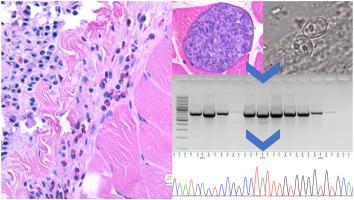International Journal for Parasitology: Parasites and Wildlife ( IF 2.0 ) Pub Date : 2020-10-01 , DOI: 10.1016/j.ijppaw.2020.09.005 Walter Basso , Cristian A. Alvarez Rojas , Daniel Buob , Maja Ruetten , Peter Deplazes

|
Red deer (Cervus elaphus) carcasses showing grey-greenish discolouration have been increasingly observed in the canton of Grisons, Switzerland. We investigated whether Sarcocystis infections were associated with this pathology, and whether wild and domestic canids were involved in their transmission. Meat from affected red deer (n = 26), faeces and intestines from red foxes (Vulpes vulpes) (n = 126), and faeces from hunting dogs (n = 12) from the region, were analysed. Eosinophilic myositis and/or fasciitis were diagnosed in 69% of the deer, and sarcocysts were observed in 89% of the animals. Molecular typing targeting a ~700bp variable region of the 18S rRNA gene revealed Sarcocystis hjorti in 73%, S. venatoria/S. iberica in 54%, S. linearis/S. taeniata in 12%, S. pilosa in 8% and S. ovalis in 4% of the deer samples. No inflammatory changes were observed in red deer carcasses with normal appearance (n = 8); however, sarcocysts were observed in one sample, and S. hjorti, S. venatoria/S. iberica or S. silva DNA was detected in five samples. Sarcocystis oocysts/sporocysts were observed in 11/106 faecal and 6/20 intestinal fox samples, and in 2/12 canine samples. Sarcocystis tenella (n = 8), S. hjorti (n = 2), S. gracilis (n = 2), and S. miescheriana (n = 1) were identified in foxes, and S. gracilis (n = 2), S. capreolicanis (n = 1) and S. linearis/S. taeniata (n = 1) in dogs. This study provides first molecular evidence of S. pilosa and S. silva infection in red deer and S. linearis/S. taeniata in dogs and represents the first record of S. ovalis transmitted by corvids in Central Europe. Although Sarcocystis species infecting red deer are not regarded as zoonotic, the affected carcasses can be declared as unfit for human consumption due to the extensive pathological changes.
中文翻译:

瑞士的嗜酸性粒细胞性肌炎/筋膜炎对马鹿的肉囊肿感染,传播过程中涉及红狐狸(Vulpes vulpes)和猎狗
马鹿(马鹿表示灰度绿色变色)屠体已在格劳宾登,瑞士的州被越来越多地观察到。我们调查了肉囊肿感染是否与这种病理有关,以及野生和家庭犬科动物是否参与其传播。从受影响的马鹿(肉N = 26),从红色狐狸粪便和肠(赤 狐)(N = 126),并从猎狗粪便(N =12)来自该地区,进行了分析。在69%的鹿中诊断出嗜酸性肌炎和/或筋膜炎,在89%的动物中发现了囊肿。靶向18S rRNA基因约700bp可变区的分子分型显示,S。venatoria / S占73%的Sarcocystis hjorti 。iberica占54%,S。linearis / S。taeniata(12%),S。pilosa(8%)和卵形链球菌(S.卵圆形)(4%)。在外观正常的马鹿尸体中未观察到炎症变化(n = 8);然而,在一个样品中观察到了卵囊,而在S. hjorti,S. venatoria / S。中则观察到了。iberica或S.silva在五个样品中检测到DNA。在11/106粪便和6/20肠道狐狸样本以及2/12犬样本中观察到了肉囊虫卵囊/孢子囊。肉孢子球虫(N = 8),S. hjorti(N = 2),S.眼虫(N = 2),和S. miescheriana(N = 1)在狐狸进行鉴定,和S.眼虫(Ñ = 2),S. capreolicanis(n = 1)和S. linearis / S。 狗中的taeniata(n = 1)。这项研究提供了S. pilosa的第一个分子证据和S.席尔瓦感染马鹿和S.线形/ S。taeniata在狗和代表的第一条记录S.卵圆由中欧鸦科传输。尽管不认为感染马鹿的肉囊藻物种是人畜共患病的,但由于广泛的病理变化,受影响的declared体可被宣布为不适合人类食用。











































 京公网安备 11010802027423号
京公网安备 11010802027423号